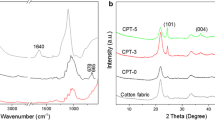Abstract
Continuous photografting/crosslinking of polyethyleneglycol dimethacrylate oligomers onto cotton using a water-soluble benzophenone photoinitiator was investigated. Photografting increased with increasing irradiation dose, oligomer concentration and photoinitiator concentration. Maximum grafting efficiency of DM 400 and 600 were 83% and 79%, respectively. The photografting increased the wrinkle resistance of cotton implying surface crosslinking of cotton. Both surface crosslinking and bulk crosslinking of cotton were accomplished via dual curing of a mixed formulation containing both a thermally curable component (BTCA/SHP) and a UV-curable component. The wrinkle resistance of the crosslinked cotton was found to be higher when cured by thermal curing after UV curing rather than by UV curing after thermal curing due to the facile post-polymerization of the UV active component. The presence of crosslinks in the dually crosslinked cotton was verified with FT-IR and thermogravimetric analysis.
Similar content being viewed by others
References
C. M. Welch,Rev. Prog. Coloration,22, 32 (1992).
C. M. Welch and B. A. Kottes-Andrews,Text. Chem. Color.,21(2), 13 (1989).
I. S. Kang, C. Q. Yang, and W. Wei,Text. Res. J.,68, 865 (1998).
W. Wei and C. Q. Yang,Text. Res. J.,69, 145 (1999).
N. R. S. Hollies,Text. Res. J.,37, 277 (1967).
K. Yamamoto,Text. Res. J.,52, 363 (1982).
S. P. Rowland,Text. Chem. Color.,18(3), 25 (1986).
Y, Shin, N. R. S. Hollies, and K. Yeh,Text. Res. J.,59, 635 (1989).
H. Choi,Text. Res. J.,62, 614 (1992).
B. Rånby,Polym. Eng. Sci.,38, 1129 (1998).
J. Jang and C. M. Carr,J. Text. Inst.,90, Part 1, No. 3, 412 (1999).
J. Jang and C. M. Carr,J. Kor. Fiber Soc.,36, 176 (1999).
A. Hebeishand and J. T. Guthrie, “The Chemistry and Technology of Cellulosic Copolymers”, Springer-Verlag, Berlin, 1981.
S. Peeters, “Radiation Curing in Polymer Science and Technology”, (J. P. Foussier and J. F. Rabek Eds.), Vol. III, Elsevier Applied Science, London, 1993.
B. C. Smith, “Infrared Spectral Interpretation: a Systematic Approach”, CRC Press, New York, 1999.
C. Q. Yang and B. A. Kottes-Andrews,J. Appl. Polym. Sci.,43, 1609 (1991).
B. J. Trask-Morell, B. A. Kottes-Andrews, and E. A. Catalano,J. Appl. Polym. Sci.,48, 1475 (1993).
B. J. Trask-Morell and B. A. Kottes-Andrews,Text. Res. J.,64, 729 (1994).
Author information
Authors and Affiliations
Corresponding author
Rights and permissions
About this article
Cite this article
Jang, J., Yoon, KC. & Ko, SW. Durable press finish of cotton via dual curing using UV light and heat. Fibers Polym 2, 184–189 (2001). https://doi.org/10.1007/BF02875343
Received:
Revised:
Accepted:
Issue Date:
DOI: https://doi.org/10.1007/BF02875343



